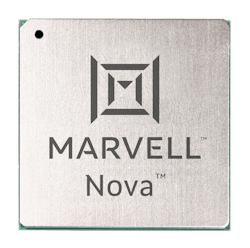Marvell®’s Nova 1.6 Tbps PAM4 electro-optics platform enables high-speed data movement in artificial intelligence (AI) / machine learning (ML) and data center networks. Powered by a 200 Gbps/lambda optical DSP, Nova doubles the optical bandwidth of current solutions to enable 1.6 Tbps pluggable modules for scaling AI clusters. Nova extends the multi-source pluggable optics ecosystem and provides the advanced technology needed to alleviate data center network bottlenecks as the industry transitions to 51.2 Tbps networking architectures. The Nova 1.6 Tbps PAM4 electro-optics platform enables the scaling of data interconnect transfer speeds to meet the needs of the most demanding AI workloads. Nova PAM4-based optical modules double the networking bandwidth while reducing power and cost per bit by 30%. By doubling the bandwidth per lambda, the Nova-based modules reduce the number of lasers and related optical components by 50%.
Judge’s Comment: “Marvell's Nova platform took the industry from talking about 1.6Tbits to experiencing it.”

